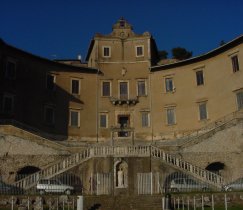The National Archeological Museum - Barberini Palace
Built towards 1500 above the portico with the cavea of the Sanctuary of the Fortuna primigenia,Palazzo Barberini was formerly a fortress belonging to the Colonna family.
In 1630 the Colonnas sold the fief of Palestrina to the Barberini family; the baronial palace was many times modified and it was at the end of the XV Century that its integration with the older buildings was begun, later completed by will of Taddeo Barberini (1640).
The Palazzo Barberini was turned into a famous and rich museum in 1953: the National Museum of Archaeology. It has been recently restored and contains the most important works from the ancient town of Praeneste.
The famous sculpture, recently recovered in Guidonia, called the Triade Capitolina, representing Jove, Juno and Minerva on the throne, is exibited on the first floor at the entrance to the museum. It's the only example of the Triad in which the gods are preserved virtually in their entirety.
The second floor is dedicated to findings from excavations at the temple and the nearby necropolis excavated in the 17th century: epigraphes, reliefs, inscriptions, objects in terracotta, funerary trappings and portraits, some votive material and a a splendid collection of ceramics, bronze statuettes and, in the last hall, urns and sarcophagi.
On the third floor is conserved the large polichrome mosaic called Nile Mosaic which must have been the paving to the floor of the apse of the Aula. It dates back to the last years of the second century BC and it is the largest Hellenic mosaic still in existence. It depicts a sort of map of Egypt at the time of the flooding by the Nile, a scenic descriptions of the course of the river Nile, meandering through Egyptian landscapes with lions and crocodiles, until it reaches trading sea ports, where Roman merchant ships are awaiting.
Surroundings
-
The Sacro Speco

An impressive complex of buildings which almost looks as if it is one with the surrounding rock...
To know more
-
Rocca Pia
Built on the place where Callisto II Borgia's Castle was situated...
-
Church of St.Peter
It was built on the rests of a roman villa...
Tivoli's attractions

Patrocinio Comune di Tivoli
Assessorato al Turismo



